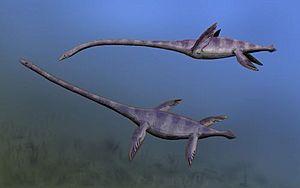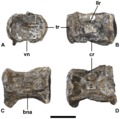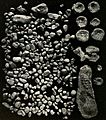Elasmosaurus facts for kids
Quick facts for kids ElasmosaurusTemporal range: Upper Cretaceous
80.5 mya |
|
|---|---|
 |
|
| Elasmosaurus platyurus | |
| Scientific classification | |
| Kingdom: | |
| Class: | |
| Superorder: | |
| Order: | |
| Family: |
†Elasmosauridae
|
| Genus: |
†Elasmosaurus
Cope, 1868
|
Elasmosaurus was a huge swimming reptile that lived about 80.5 million years ago during the Upper Cretaceous period. It was a type of plesiosaur, known for its incredibly long neck. This amazing creature swam in the Western Interior Seaway, which was a large inland sea that covered much of North America back then.
When it was first found in 1868, a scientist named Edward Drinker Cope made a famous mistake: he accidentally put the Elasmosaurus's head on its tail! This reptile had an amazing 71 neck bones (called cervical vertebrae). Scientists think Elasmosaurus might have swum near the surface, snatching small fish that fed on tiny ocean life called plankton.
Contents
What it Looked Like
Elasmosaurus was a very long plesiosaur, reaching about 10.3 meters (38 feet) in length. Imagine a school bus, but longer! Like other elasmosaurids, it had a tiny head on a super long neck, four strong flippers, and a short tail. Elasmosaurus and its close relative, Albertonectes, had the longest necks of any animals ever known to have lived.
Its snout (the front part of its face) was rounded. We don't know exactly how many teeth Elasmosaurus had because its fossils are incomplete. However, it probably had six teeth in the front part of its upper jaw, which were shaped like big fangs. The teeth at the very front were smaller than the ones behind them. The teeth in the back of its jaws seemed to be smaller too.
One of the most special things about Elasmosaurus was its neck. It had 72 neck bones, which is more than any other plesiosaur except for Albertonectes, which had 75. These two plesiosaurs hold the record for the most neck bones among all vertebrates (animals with backbones)!
The front two neck bones, called the atlas and axis bone, connected to the back of its skull. These bones were horizontally rectangular. The main parts of these bones were fused together in the first Elasmosaurus fossil found, which tells us it was an adult.
Like most elasmosaurids, Elasmosaurus also had about three chest bones (pectoral vertebrae). Its tail had at least 18 bones. Its flippers were strong and paddle-like, helping it move through the water.
How it was Discovered
The first Elasmosaurus fossil, named Elasmosaurus platyurus, was found in March 1868. It was discovered by Dr. Theophilus Turner, a military doctor, in western Kansas, United States. Even though other elasmosaur fossils have been found in North America, scientists believe Elasmosaurus platyurus is the only true species of Elasmosaurus.
Dr. Turner found the bones in 1867 near a railroad track close to McAllaster, Kansas. He gave some parts to John LeConte, who was working for the railroad. LeConte then sent them to Edward Drinker Cope in Philadelphia. Cope quickly realized these were the remains of a new plesiosaur. He asked Turner to send the rest of the fossil.
Cope got the rest of the bones in mid-March 1868. Just two weeks later, he announced it was a new species of plesiosaur, which he named Elasmosaurus platyurus. This name means "flat-tailed, thin-plate reptile" in Greek.
Here's the funny part: Cope made a big mistake! He thought the long neck bones were tail bones, and the short tail bones were neck bones. So, he put the head on the wrong end of the skeleton in his first drawing! Two years later, another famous scientist, Joseph Leidy, who had taught Cope, pointed out the error. Cope was very embarrassed and tried to recall all the copies of his paper. This mistake became quite famous in the history of paleontology.
Family Tree
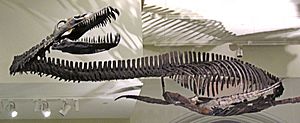
Many species of Elasmosaurus have been named since its discovery. However, a study in 1999 by Ken Carpenter showed that only Elasmosaurus platyurus is truly valid. Other species that were once called Elasmosaurus have since been moved to different groups. For example, E. serpentinus is now called Hydralmosaurus, and E. snowii is now Styxosaurus.
By the Late Cretaceous period, there were two main groups of plesiosaurs left. Elasmosaurus gives its name to one of these groups, the elasmosaurids. These were the ones with extremely long necks and relatively small heads. The other group, called polycotylids, had shorter necks and bigger heads.
Scientists use a "family tree" called a cladogram to show how different animals are related. Here's how Elasmosaurus fits into the Elasmosauridae family:
| Elasmosauridae |
|
||||||||||||||||||||||||||||||||||||||||||||||||||||||||||||||||||||||||||||||||||||||||||||||||
How it Lived
Daily Life
Scientists believe Elasmosaurus spent most of its life in the open ocean. Its unique body shape meant it couldn't swim very fast. Its flippers probably moved like a bird's wings, but they were stiff and couldn't twist. This means Elasmosaurus couldn't come onto land to lay eggs like sea turtles do. Instead, it most likely gave birth to live young in the water, just like sea snakes. We know this because a fossil of an adult Polycotylus (another type of plesiosaur) was found with a baby inside!
Neck Use
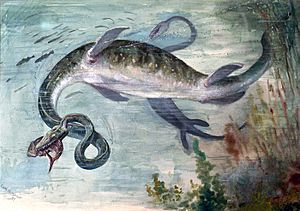
Even though Elasmosaurus had a super long neck, it couldn't lift it high out of the water like a swan. The neck was too heavy, and the muscles weren't strong enough to hold it up against gravity. It could only lift its head and neck above the water if it was in shallow areas where its body could rest on the bottom.
The head and shoulders of Elasmosaurus likely acted like a rudder, helping the animal steer. If it moved the front part of its body in one direction, the rest of its body would follow. This means Elasmosaurus couldn't swim one way while moving its head and neck in a completely different direction.
Studies show that the necks of elasmosaurs could bend quite a bit, allowing for gentle curves. However, they couldn't make sharp, S-shaped bends like a snake. Some people thought the long neck might have worked like a snorkel, letting them breathe while their body stayed underwater. But this isn't likely because of the huge water pressure differences and other problems. Also, a long neck could have been an easy target for predators.
What it Ate
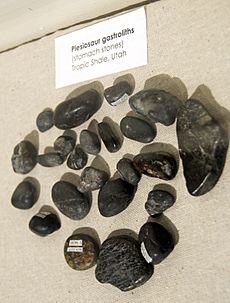
The flexible neck of Elasmosaurus would have allowed it to hunt in different ways. It might have "grazed" along the ocean floor, using its head and neck to search for prey hidden in the mud. Elasmosaurs might also have been active hunters in the open water. They could have pulled their necks back and then quickly launched a strike, or used side-to-side movements to stun or kill prey with their teeth.
It's possible that Elasmosaurus hunted schools of fish by hiding below them and slowly raising its head. Its eyes were on top of its head, allowing it to see straight up. This stereoscopic vision (seeing with both eyes to judge distance) would have helped it spot small prey. Hunting from below would also have helped by making the prey look like dark shapes against the sunlight, while Elasmosaurus stayed hidden in the darker water below.
Elasmosaurs probably ate small bony fish and marine invertebrates (animals without backbones, like squid). Their small skulls meant they couldn't eat very large prey. Their long, thin teeth were good for grabbing prey, not for tearing it apart, so they likely swallowed their food whole. Like some modern animals, Elasmosaurus swallowed small stones to help grind up its food in its stomach.
Images for kids
-
Officers at Fort Wallace, Kansas, in 1867. Turner, who the same year discovered Elasmosaurus in the area, is second from left.
-
Back vertebrae of the holotype (first specimen found), 1869
-
1869 drawing of Benjamin Waterhouse Hawkins' workshop in Central Park; the rounded shapes in the lower center left may be the rocks that contained the now missing hip and shoulder fossils of the holotype.
-
Cope's old 1869 drawing of fossil reptiles from New Jersey, including a short-necked E. orientalis (now a different species) fighting a Dryptosaurus.
-
A bone from Plesiosaurus constrictus, which Cope mistakenly thought belonged to Elasmosaurus.
-
Bones of E. haasti (now Mauisaurus haasti).
-
An old drawing by Samuel Wendell Williston (1914) showing Elasmosaurus with its neck incorrectly raised high out of the water.
-
Stomach stones and bones (right) from an unknown plesiosaur found in Kansas.
-
A map showing the Western Interior Seaway during the Late Cretaceous period, about 80 million years ago.
See also
 In Spanish: Elasmosaurus para niños
In Spanish: Elasmosaurus para niños



